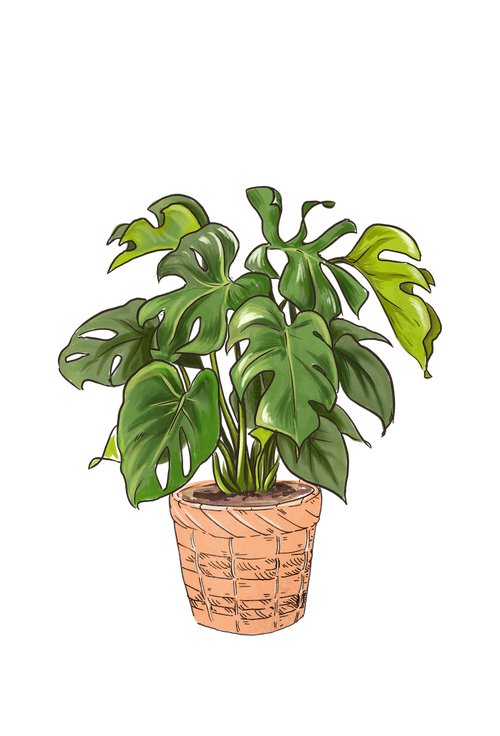Monstera Care Guide

-
Light : Medium
Medium to bright indirect light. Never direct sunlight.
-
Water : Medium
Enjoys being on the moist, but not soggy side.
-
Humidity : High
Enjoys high humidity. Spritz occasionally.
-
Temp : 65℉ - 90℉
The Swiss Cheese Plant likes warmth and to stay above 50°F with high humidity.
-
Zone : 8|9|10|11
Outside: Grow in morning light, partial shade (4-6 hours) where nights are above 50°F.
Indoors: This plant prefers bright, to medium indirect light for at least six hours in a southern, eastern and western windows.
-
Fertilizer : Monthly
Fertilize during their growing period in the spring and summer months between February and October every 2-3 weeks. Use a balanced liquid fertilizer at 1/2 strength. Reduce fertilizing during the fall and winter to once a month while the plant is in their dormant phase. Raise the humidity around them and never use chlorine or fluoride in the water.
-
Repotting : 2 Years
When receiving the plant, do not repot immediately but wait at least 6-12 months or if the roots are beginning to get crowded and growing through the drainage holes.
Repot in the spring, using a 2" bigger pot to keep the roots drier. (Too big of a pot could cause the soil to dry slower, which is not helpful.) Use a well-draining indoor potting mix with perlite to help with drainage.
Water your plant in the old pot before transferring over and let sit an hour. Place a piece of screening at the bottom of the container over the drainage hole to secure the soil and allow to drain. Add soil to the bottom to elevate the root ball. Lift the plant and release the roots against the existing planter. Use a clean knife or garden trowel to wedge between the pot and the soil to loosen.
Inspect the root ball. Notice if there are any dead or rotting roots and trim off with sterile pruners. If the plant is rootbound, cut through the roots to alleviate continued encircling.
Ensure the plant is sitting about 1" below the edge of the pot to avoid water spillage. Add more soil and backfill around the sides by tamping down. Fill up to the soil line but not over.
Water thoroughly, leaving the soil damp but not soggy. If settling occurs, add more soil.
-
Cleaning : Bi-annually
Wear gloves while working with this plant, as they have a sap that causes skin irritation. Trim off any yellowing bottom leaves down to the base of the stem using a sharp knife. Remove any debris off the soil surface. Train your plant to grow up a moss pole and tie them up to promote upward growth. Wipe the leaves with a clean, damp cloth using filtered or rain water. Support the leaf by wiping them from the stem to the tip of the leaf on both sides. Spritzing the leaves is another way to wet them and wipe them clean.
-
Propagation : Cuttings
Take cuttings just below an aerial root.
Remove the bottom leaves on the stem with sterile scissors or a knife. Place the cutting in a container tall enough to hold the leaf upright. Add about an inch of water at the bottom and change the water weekly.
Keep the leaf in medium indirect sunlight while they are beginning to form roots.
Once roots are at least 1-2 inches long, plant them with rooting hormone mixed into the well-draining potting mix.
Water and place in bright to medium, indirect light.